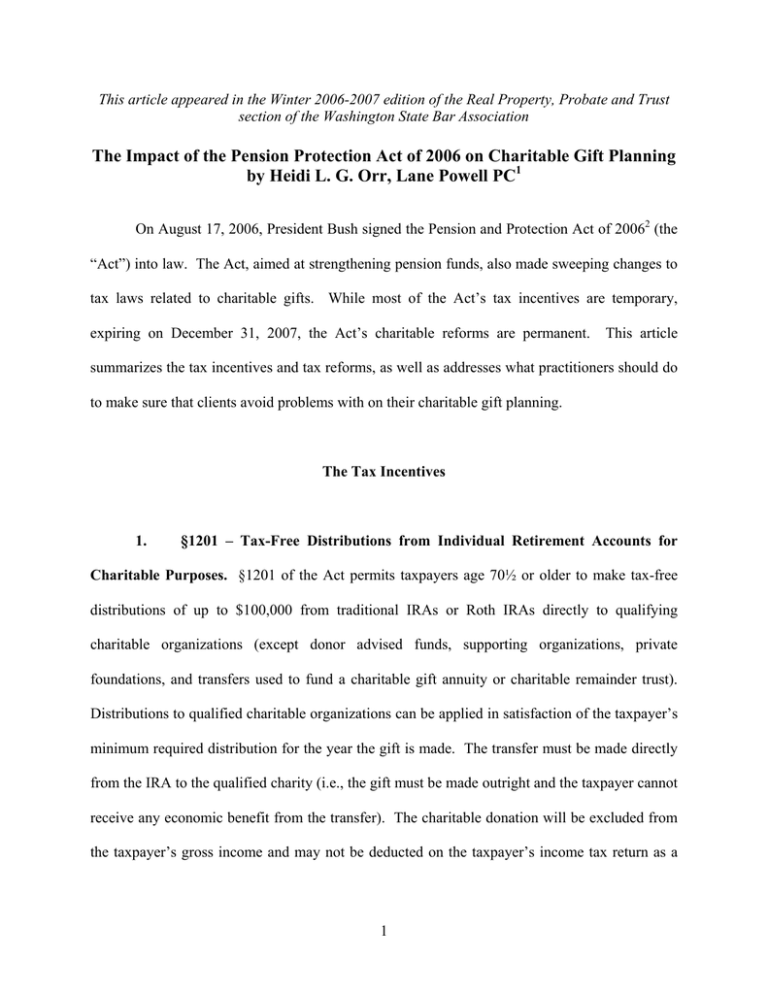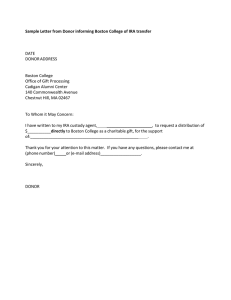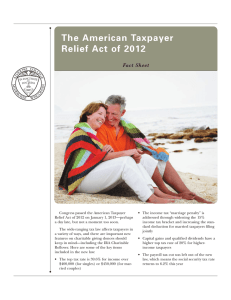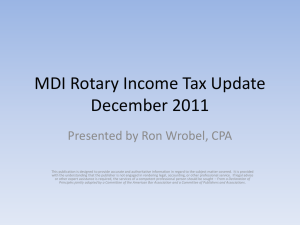This article appeared in the Winter 2006-2007 edition of the... section of the Washington State Bar Association
advertisement

This article appeared in the Winter 2006-2007 edition of the Real Property, Probate and Trust section of the Washington State Bar Association The Impact of the Pension Protection Act of 2006 on Charitable Gift Planning by Heidi L. G. Orr, Lane Powell PC1 On August 17, 2006, President Bush signed the Pension and Protection Act of 20062 (the “Act”) into law. The Act, aimed at strengthening pension funds, also made sweeping changes to tax laws related to charitable gifts. While most of the Act’s tax incentives are temporary, expiring on December 31, 2007, the Act’s charitable reforms are permanent. This article summarizes the tax incentives and tax reforms, as well as addresses what practitioners should do to make sure that clients avoid problems with on their charitable gift planning. The Tax Incentives 1. §1201 – Tax-Free Distributions from Individual Retirement Accounts for Charitable Purposes. §1201 of the Act permits taxpayers age 70½ or older to make tax-free distributions of up to $100,000 from traditional IRAs or Roth IRAs directly to qualifying charitable organizations (except donor advised funds, supporting organizations, private foundations, and transfers used to fund a charitable gift annuity or charitable remainder trust). Distributions to qualified charitable organizations can be applied in satisfaction of the taxpayer’s minimum required distribution for the year the gift is made. The transfer must be made directly from the IRA to the qualified charity (i.e., the gift must be made outright and the taxpayer cannot receive any economic benefit from the transfer). The charitable donation will be excluded from the taxpayer’s gross income and may not be deducted on the taxpayer’s income tax return as a 1 charitable contribution. The tax-free distribution applies only to traditional IRAs and Roth IRAs.3 This provision will expire on December 31, 2007. Earlier this year, in Notice 2007-7, 2007-54, the Internal Revenue Service provided additional guidance regarding IRA distributions to qualified charitable organizations. In addition to the guidance set forth in the Act, the Notice provided the following additional guidelines: ¾ A charitable IRA distribution can be made from a SEP IRA or a Simple IRA as long as the SEP IRA or Simple IRA is not an “ongoing” IRA. A SEP IRA or Simple IRA is “ongoing” if an employer contribution was made to it during the same year in which a charitable IRA distribution would be made. Therefore, a retired taxpayer who has a SEP IRA or a Simple IRA can make charitable distributions from that IRA because an employer would not have made a contribution to the retired taxpayer’s SEP IRA or Simple IRA in that year. (See Q & A 36.) ¾ A taxpayer over age 70½ who is the beneficiary of an inherited IRA can take advantage of the charitable IRA exclusion. (See Q & A 37.) ¾ A qualified charitable IRA distribution is not subject to withholding under IRC §3405 because the taxpayer that requests such a distribution is deemed to have elected out of withholding under IRC §3405(a)(2). (See Q & A 40.) ¾ Distributions made by an IRA trustee directly to charitable organizations will be treated as a receipt by the IRA owner and therefore will not constitute a prohibited transaction. This rule applies to taxpayers with outstanding pledges to the recipient charitable organization. In other words, charitable IRA distributions can be used to satisfy pledges without violating the self-dealing prohibited transaction rules (See Q & A 44). The taxpayers who will benefit most from the ability to make tax-free distributions from individual retirement accounts include taxpayers: (1) who are required to take minimum required distributions, but who do not need additional income; (2) who have exceeded the 50% adjusted gross income limitations for gifts; (3) who do not itemize their deductions on their income tax returns; or (4) whose major asset is an IRA. 2 Many practitioners will have clients who want to take advantage of this charitable giving opportunity. Given that the tax-free distribution option is new and IRA custodians will approach the process differently, practitioners should manage the transfer to make sure it takes place properly. Specifically, practitioners should: (1) advise the taxpayer to start the transfer early in the year and carefully document the transfer; (2) provide a letter of instruction to the IRA custodian to help ensure the taxpayer’s intent to comply with the tax-free distribution under the Act; (3) assist taxpayers in determining whether the charitable recipient is a qualified charity; and (4) make sure the taxpayer receives an acknowledgement of the gift from the charitable organization, which acknowledgement should state that nothing of value was provided to the taxpayer in exchange for the gift.5 2. §1203 – Basis Adjustment to Stock of S Corporation Contributing Property. The Act provides more favorable basis rules for gifts made by S Corporations. This change, which expires on December 31, 2007, provides that an S Corporation shareholder’s basis reduction in his or her stock, by reason of a charitable contribution made by the S Corporation, will be equal to the shareholder’s pro rata share of the adjusted basis of the contributed property. 3. §1206 – Qualified Conservation Contributions. The Act increases the charitable deduction limit from 30% of adjusted gross income to 50% of adjusted gross income for qualified conservation contributions. This charitable deduction limit is raised to 100% of adjusted gross income for qualified farmers or ranchers. The provision allows taxpayers to carry forward and deduct the remainder over fifteen years. This incentive expires on December 31, 2007. 3 The Tax Reforms 1. §1211 – Charity Owned Life Insurance. The Act provides that charitable organizations must report acquisitions of interests in insurance contracts for two years beginning on the date of enactment of the Act. The Secretary is required to issue a report within thirty months after the date of enactment examining whether such acquisitions are consistent with the tax-exempt purposes of those charitable organizations that acquire such insurance contracts. This reporting requirement does not apply to a donor who purchases a policy on his or her life and gives it to a charity or to donors who name a charity as the beneficiary of a life insurance policy. 2. §1212 – Increase in Excise Taxes Relating to Public Charities, Social Welfare Organizations, and Private Foundations. The Act doubles the fines, penalties, and excise taxes for violations by private foundations and their managers for acts of self-dealing, excess benefit transactions, failing to distribute income, excess business holdings, jeopardizing investments, and taxable expenditures. Generally, the Act doubled the percentage of the taxes assessed, as well as the dollar limitations on the amount of initial and additional taxes. 3. §1213 – Charitable Contributions of Easements in Registered Historic Districts. The Act provides that deductions for donations of land or structures located in registered historic districts will only be allowed if the entire exterior6 of the building is preserved. The donated interest must include a restriction prohibiting any change in the exterior 4 of the building that is inconsistent with the building’s historical character. The taxpayer must enter into a written agreement with the charitable organization certifying that the charity is a qualified public charity whose purpose is environmental protection, open space preservation, or historic preservation, and that the charity has the resources to manage and enforce the restriction and the commitment to do so. The taxpayer must include a qualified appraisal with his or her tax return, photographs of the entire exterior of the building, and a description of all restrictions on the development of the building. The Act also reduces the taxpayer’s charitable deduction if a rehabilitation tax credit has been claimed with respect to the property in the last five years. 4. §1214 – Charitable Contributions of Taxidermy Property. The Act limits the basis for donated taxidermy property to the cost of preparing, stuffing, and mounting the property. The value of the deduction is equal to the lesser of basis or fair market value. 5. §1215 – Recapture of Tax Benefit for Charitable Contributions of Exempt Use Property not Used for an Exempt Purpose. The Act provides that contributions of tangible personal property may be subject to recapture of the tax benefit if the donee charitable organization disposes of the property within three years following the donation. In order for the taxpayer to receive a charitable deduction equal to the fair market value of the donated property, the charitable organization is required to use the property for three years before selling or disposing or it. The charitable organization must also provide both the taxpayer and the Internal Revenue Service a statement: (a) certifying that the use of the property is related to the charitable organization’s exempt purpose; and (b) describing how the property was used and furthered such exempt purpose, or stating the intended use of the property by the charitable organization at the 5 time of the contribution and that the intended use has become impossible or infeasible to implement. If the charitable organization sells or otherwise disposes of the property within three years of the contribution and does not file a certification, the donor’s charitable deduction is reduced from fair market value to cost basis. Any person who identifies tangible personal property as having a use that is related to an exempt purpose and who knows that the property is not actually intended for such use is subject to a $10,000 penalty. 6. §1216 – Clothing and Household Items. The Act provides that deductions are no longer allowed for contributions of clothing or household items unless the clothing or household item is in good used condition or better. The Act does not define the term “good used condition.” In any case, taxpayers can no longer take deductions for used socks and undergarments donated to charity. Household items include furniture, electronics, and similar items, but not food, paintings, antiques, jewelry, and collections. Taxpayers who claim a deduction of more than $500 for any single item of clothing or household item must file a qualified appraisal with respect to the property. 7. §1217 – Recordkeeping Requirements. The Act provides that no deduction shall be allowed for any contribution of a cash, check, or other monetary gift unless the donor maintains a record of the contribution (e.g., bank statement, cancelled check, or credit card statement to proving the donation was made) or a written communication from the charitable organization showing the name of the charitable organization, the date of the contribution, and the amount of the contribution. In other words, taxpayers will no longer be able to deduct cash gifts left in grocery store jars or church collection plates or coins dropped in Salvation Army 6 buckets unless the taxpayer can obtain a receipt or other record of the gift. This rule applies regardless of the amount of the contribution. While taxpayers are not required to submit their receipts with their income tax returns, they are required to retain the receipts in order to substantiate their charitable deductions to the Internal Revenue Service in the event of an audit. 8. §1218 – Contributions of Fractional Interests in Tangible Personal Property. The Act provides that taxpayers making fractional interest gifts of tangible personal property (e.g., artwork) must give the entire interest in the property to the charitable organization within ten years of the initial contribution or upon death, whichever occurs first. To avoid recapture of the taxpayer’s charitable deduction and the imposition of a 10% penalty, the charitable organization must have taken substantial physical possession of the property and used the property in furtherance of its exempt purpose. The deductible amount of additional contributions will be the lesser of the fair market value of the property at the time of the initial fractional contribution or the fair market value of the property at the time of the additional contribution. In other words, the deduction does not take into account the appreciation in later years of the taxpayer’s retained fractional interest in the property. Most property that a taxpayer would use to make fractional interest gifts will appreciate with time, which could make fractional interest gifts of tangible personal property problematic if the taxpayer bequeaths the retained interest to charity at death. The fractional interest in the property retained by the taxpayer will be included in the taxpayer’s estate at death at its then fair market value, but a deduction will not be allowed for any appreciation occurring after the date of the initial gift. Therefore, a taxpayer would be subject to unwanted and unintended estate taxes if the final fractional contribution occurs at death. 7 9. §1219 – Provisions Relating to Substantial and Gross Overstatements of Valuations. The Act applies additional penalties to taxpayers who claim gift tax deductions for property based on valuations that overstate the property’s value by 150% or more. The reasonable cause exception for gross valuation misstatements was also eliminated. The Act also defines “qualified appraisals” and “qualified appraisers” for substantial and gross valuation misstatements. 10. §1226 and §1231 - §1235 – Extending the Application of the Private Foundation Excise Taxes and New Excise Taxes to Donor Advised Funds. The Act directs the Secretary to study the organization and operation of donor advised funds and supporting organizations and make a report to Congress within a year. The Act also directs the Secretary to consider whether deductions should be allowed for contributions to donor advised funds, whether donor advised funds should be required to distribute a specific amount each year, and whether the retention by donors of rights or privileges is consistent with the treatment of such transfers as completed gifts for tax purposes. In the meantime, the Act did address certain issues related to donor advised funds. The Act defines (for the first time) a donor advised fund as a fund or account that is separately identified by reference to contributions of a donor or donors, is owned and controlled by a sponsoring organization, and with respect to which a donor has or reasonably expects to have, advisory privileges with respect to the distribution or investment of amounts held in the fund or account by reason of the donor’s status as donor. The Act also extended the application of the 8 private foundation excise taxes to donor advised funds and added new excise taxes applicable to donor advised funds, as follows: a. Taxable Distributions. A taxable distribution is defined as any distribution to an individual or to any other person if the distribution is for non-charitable purposes or the sponsoring organization does not exercise expenditure responsibility with respect to such distributions. A 20% tax will be imposed on the sponsoring organization on each taxable distribution and a 5% tax will be imposed on any fund manager approving the distribution knowing it is a taxable distribution. b. Prohibited Benefits. Donor advised funds are prohibited from making distributions that create more than an incidental benefit to the fund donor, a fund advisor, a family member of the donor or advisor, or an entity controlled7 by the donor, donor’s advisor, or their family members. A tax equal to 125% of the improper benefit will be imposed on the donor, donor advisor, or other related person, and a tax equal to 10% of the improper benefit will be imposed on the fund manager who approves the distribution knowing it would confer a more than incidental benefit. c. Excess Benefit Transactions. The excess benefit transaction rules were amended to treat grants, loans, compensation, expense reimbursement or similar payments made by a donor advised fund to a donor, advisor, or party related to a donor advised fund as an excess benefit transaction subject to excess benefit transaction taxes. The entire amount paid to a donor, donor advisor, or related party will be treated as an excess benefit. 9 *** The Act creates both planning opportunities and potential pitfalls for taxpayers. Practitioners should both encourage clients to consult with their tax advisors before making substantial charitable donations and continue to carefully advise taxpayers with respect to their charitable gifting options, while exploring other planning techniques available to help clients meet their charitable planning goals. 1 Heidi L. G. Orr is a shareholder with the Seattle firm of Lane Powell PC. Her practice focuses on estate planning, estate and gift tax, probate and trust administration, and charitable gift planning. 2 The text of the Pension Protection Act of 2006 is available at www.dol.gov/ebsa/pdf/ppa2006.pdf. 3 Taxpayers may not make tax-free distributions from other forms of retirement plans such as 401(k) and 403(b) plans, defined benefit and contribution plans, profit sharing plans, Keoghs, or employer sponsored SEPs and SIMPLE plans. Owners of these types of plans may want to consider rolling certain amounts into an IRA in order to take advantage of this tax incentive. 4 See IRS Notice 2007-7, 2007-5 I.R.B. 395. 5 A check or electronic transfer from the IRA custodian will likely not state the taxpayer’s name. Therefore, the practitioner should remind the taxpayer to alert the charitable organization that the gift is on its way and to follow up with the charitable organization to ensure receipt of an acknowledgement. 6 Including the front, sides, rear, and height of the building. 7 Control is defined as at least 35% of the voting interest in an entity. 10




![Sample Letter to IRA Administrators Re: [insert donor's name]](http://s2.studylib.net/store/data/011091828_1-1539f7035f828b9a4e7e7829cb9c07e3-300x300.png)

